Reviving Endangered Scripts: Samrat Jha
Welcome to the latest monthly Endangered Alphabets feature about calligraphy and type design–in indigenous and minority writing systems.
Here’s the point. If a script exists only in historical documents, engravings, and inscriptions, it is all too easy to assume it is no longer in use, and the culture that created it has also been lost.
But if that script can still be seen, and what’s more, if it can be seen in new, interesting and creative forms, it’s a sign of life, energy, passion, commitment. It not only shows that unfamiliar script to the world in striking and memorable ways, it shows the user community that their traditional writing is still alive, and they have not been forgotten. Of course, communities also feel connected to their scripts because they are deeply familiar, so a designer or calligrapher has to walk a fine line between ancient and modern!
Our aim is to present the work of calligraphers and type designers who are bringing imagination and energy to endangered alphabets, by researching, understanding and acknowledging their traditions, but also adding the expressiveness and individuality that is one of the features of a living script. This month’s profile is of Samrat Jha, who is working in both calligraphy and type design to revitalize the Tirhuta or Mithilakshar script for the Maithili language of Nepal and India.– Tim Brookes
 I learnt the [Tirhuta] script from my great grandfather, who is 109 years old. When I was in the sixth grade, we had a boy who knew 6 languages. I knew 7, but all of them were local tongues in contrast to this boy, who knew foreign languages. This made me interested in linguistics, which later developed into passion, and I came to master 33 scripts and many languages. This passion developed along with my taste for music in all these languages, [and it] also fueled my fascination for the beautiful looking characters of all these scripts.
I learnt the [Tirhuta] script from my great grandfather, who is 109 years old. When I was in the sixth grade, we had a boy who knew 6 languages. I knew 7, but all of them were local tongues in contrast to this boy, who knew foreign languages. This made me interested in linguistics, which later developed into passion, and I came to master 33 scripts and many languages. This passion developed along with my taste for music in all these languages, [and it] also fueled my fascination for the beautiful looking characters of all these scripts.
I taught myself calligraphy using a reed pen my grandfather cut me. The inspiration would usually be from the lettering on shop boards. I tried to copy them as I far as possible, and to refine my knowledge of calligraphy.
For the past 4 years, I’ve been studying my native script and have identified the various possibilities and challenges it bears.
On the basis of the manuscripts I have recovered from various time periods, the script was [at its lowest usage during] the 80s, 90s and at least the first 13 years of the of the 21st century. The script fell out of use so much that it wasn’t even heard of.
The causes of the decline?
* The [decision by the] Nepalese monarchy to remove Maithili from the official use in Nepal, and also the division of the Mithila into Bihar and Jharkhand states in India, with no provision for a state of Maithili language speakers. In short, no governmental patronage.
* The unavailability of Tirhuta typefaces in printing, [and later] in the digital interface.
* Bengali, Hindi and even Bhojpuri expansionism into the region.
* The breakdown of the Maithili language into dialects, ascertaining “independence,” for political and personal gains.
* The complex conjunct system makes it hard to learn.
* The lack of Maithili in Primary education in India. Ironically it is included in higher studies, so it is like a tree without roots.
For all these reasons, the Maithili language was devaluated and people began to shift to other Central Indic languages like Nepali and Hindi, and also languages to seek job opportunities, like English. This caused them to use Devanagari and Latin scripts heavily, so Maithili came to written in the former with of course some modifications to suit the phonology of Maithili, thus abandoning Tirhuta. All these factors also support each other and work together to bring us down.
Nowadays though there are a few people who profess in using the script, there are more people who have at least heard about the script.
The recovery, perhaps the sole and most important cause is the Internet. More and more people can be contacted here and awareness flows out to [everyone]. This has really speeded up the movement known as the Mithilakshar Saksharta Abhiyaan, which teaches people Tirhuta by many methods. YouTube videos are also available, they even have a good and a well-managed website (mithilakshar.in) but the most popular of all methods have been the Whatsapp group teaching. The program is backed by the Ministry of Education of the Indian government.
So, I wanted to jump in myself. For the last one and a half years, I have been teaching myself font designing, and though just being a beginner in this field have collaborated with multiple people.
Sensing this opportunity that could result in a full-fledged revival program, we have decided to back it by providing support for a proper font of Tirhuta online and also devise a standard “Adarshalipi” to be used in official works after achieving administrative acceptance by the governments in Bihar and Jharkhand in India, and in Nepal.
The font is also set to replace Google’s Noto Sans Tirhuta. Noto Sans fonts are generally thin, which is not suitable for Tirhuta as some of the letters will look exactly the same. Maithili requires a standard calligraphic font, especially as there are also religious factors that surround how the script should look like, such as in astrology, where also the font is hugely required. The font will also play a role in the conversion of Devanagari version of Maithili to Tirhuta, the original script for the Maithili language. I have already talked to the founder of the Maithili Wikipedia about this issue and he said he is looking forward to it. This will provide a new platform for the script digitally as well as in printing. [Until now] there has not been a single complete and perfect Tirhuta font. All the contemporary fonts you find are full of mistakes and are also not technically sound and accessible.
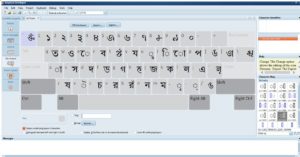 With the help of Bangladesh based Dinesharatna Prabhakara Siddhartha, we developed a Tirhuta typing tool-a Tirhuta keyboard using the Keyman’s Developer Version 9.0.
With the help of Bangladesh based Dinesharatna Prabhakara Siddhartha, we developed a Tirhuta typing tool-a Tirhuta keyboard using the Keyman’s Developer Version 9.0.
I began to sketch my own glyphs: 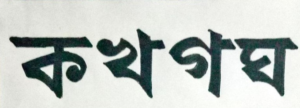
Some people complained that the existing fonts in Tirhuta were too inclined towards the classical Bengali design. Therefore, I have decided to pull back the design promised earlier and focus more on old manuscripts written in Tirhuta. An incomplete set of letters:
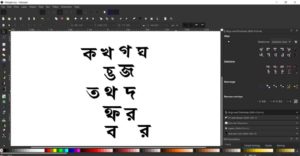
Did well based research on conjuncts for Tirhuta fonts, a feature all the other fonts have failed. Tirhuta conjuncts for writing Sanskrit:
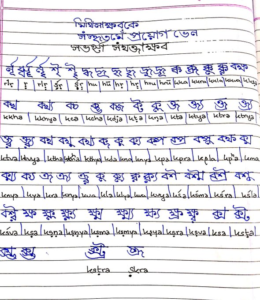
Currently, I’m busy refining my fonts:
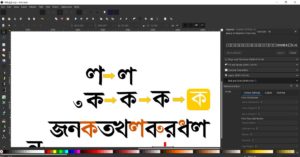
Right now, we are going through a financial crisis, we don’t have funds nor do we have any investor. When I had trained myself well, I understood that I had no funds to buy a font designing software license, and open source didn’t work for complex scripts like the Tirhuta. Thus, this is my story. Now, I’m talking to people and searching for those who can help from whatever they have.
This post is sponsored by our friends at Typotheque and Rosetta.




The Procrastinator Babble – Words Dissemble, Words Be Quick
June 5, 2021 @ 10:54 am
[…] Articles for 06-05: My nephew’s pet research project: Reviving Endangered Scripts: Samrat Jha https://www.endangeredalphabets.com/2021/05/27/reviving-endangered-scripts-samrat-jha/ […]
June 10, 2021 @ 2:00 am
Great work. God ? bless.
November 19, 2021 @ 5:43 am
I would love to work with Samrat on this with all possible help that I can. Is there a way I can connect with him?
June 1, 2022 @ 3:06 pm
I guess his contact details are given in his website mithilakshar.in
Best wishes from Bengal ^^